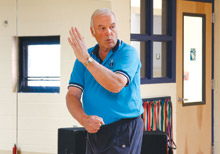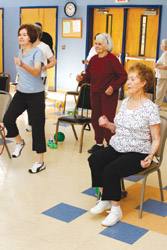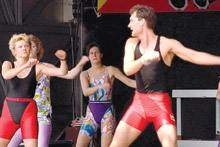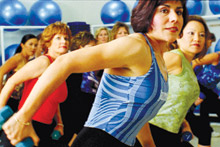The mere mention of exercise can conjure up images of sadistic P.E. teachers, striped gym socks and climbing ropes—though for those of us safely out of high school it’s unlikely that any of the aforementioned figure into our fitness regimens. For that matter, Nautilus equipment, ankle weights and chest expanders may seem equally laughable. It’s hard to separate the heart benefits from the hype.

Books like You: Staying Young: The Owner’s Manual for Extending Your Warranty, by Michael F. Roizen and Mehmet C. Oz, are topping national reading lists. Barbara Walters recently aired the special, Live to 150, Can You Do It?, and The Blue Zone: Lessons for Living Longer from the People Who’ve Lived the Longest, by National Geographic explorer Dan Buettner, documents centurions who attribute longevity not to Olympian feats but to decades of walking and bicycling combined with a healthful diet. Living not just longer, but better, is increasingly becoming the national preoccupation. That, of course, means getting and staying fit. So maybe it’s best to stick with the basics.

But few of us are content to simply eat well and jog around the block, which is why fad diets (the Atkins! the South Beach!) sound so exciting, as do their flashy workout counterparts, complete with shiny gadgetry and stylish apparel. But just how effective, at the end of the day, are these fitness crazes, and how much do they impact our bottom (and I do mean bottom) lines?
“Activities such as Tai Chi, yoga and Pilates are among the fastest growing and most popular exercises for adults,” notes the Pittsburgh Tribune-Review. The American Council on Exercise pegs balance training among growing trends, with BOSU balls, wobble boards and foam rollers cropping up at fitness centers—replacing (one can only imagine) the medicine balls, rowing machines, ballet bars and platform steps of past crazes.
“Fifteen years ago, step aerobics was really popular,” recalls Susan Macdonald, Asheville YWCA fitness director. “People just moved on from step, but it was a great workout. It was suited to younger, fit people and was higher impact than a lot of what we do now. It appealed to a more narrow range of people.” Though the YWCA doesn’t include a step class among its Club W offerings, the step isn’t completely forgotten—it’s often incorporated into other classes.
What is hot right now (besides the hot Bikram class at some area yoga centers) is the Club W “Silver Sneakers” program geared toward seniors. “As baby boomers are aging, we’ll be targeting more classes and more varied classes to seniors,” Macdonald notes. “Examples are cardio workouts while seated in chairs and seated yoga stretch. These classes are building a community that’s really committed to exercise.”
Also to be filed under “exercise community” is Jazzercise. Sure, the very name carries a certain ‘70s and ‘80s headband-and-belted-leotard cachet, but in actuality Jazzercise has come a long way, baby.
“We’ve been around 39 years. It’s been a long time,” says Susan Welch, an instructor at Jazzercise Fitness Center of Asheville. “One of the big things that sets it apart from other fitness classes is that it’s all choreographed. It makes people feel like they can dance, plus it’s a lot of fun and it’s social.”
Dance as exercise is a common theme—Macdonald notes that the YWCA offers classes in African dance, Zumba (Latin dance) and Nia (a dance variation), and local dance studios serve up everything from salsa and swing to hip-hop and belly dancing. “People are niche exercisers,” says Macdonald. “Those who love dance prefer to dance for exercise.”
And niche fitness doesn’t stop there. A recent health article on Att.net cited pole dancing (originally a strip-club move) among fast-growing exercise phenomena. And sister-sport strip aerobics, or strippercise, can be found on DVD, in dance clubs and yes, in local fitness centers (for example, check out fitness club Butterfly Life’s sexy dance-inspired “Dance Tease” class).
“It’s about keeping the heart strong,” explains Macdonald. “You can do that with pickleball [a badminton-like game] and pole dancing just as well as with marathon running.”
She adds, “There is a ‘best’ exercise for everybody. When people try a class and it doesn’t fit, I encourage them to keep looking. Some people leave out weight class to go play pickleball at the Stephens-Lee Center. There’s something out there you’ll love and be excited to do.”
The lesson here is that would-be exercisers shouldn’t give up just because they can’t slam-dunk or run a six-minute mile or bend it like Beckham. Personal trainer Pavel Stejskal, who teaches weekly classes in Asheville on how to use Russian kettlebells, points out that the activity formerly revered as an “old-school strongman type of culture” is now enjoying a revival for its healing benefits. That means learning to lift and swing the cast-iron weights builds strong backs and back endurance while also toning and sculpting.
Stejskal recommends that anyone interested in kettlebells invest in the two-hour training necessary to safely lift the weights. Even though they’ve been around at least 300 years and are now gaining in popularity in West Coast health clubs, inexperienced exercisers could harm themselves. The good news is that once trained on a few routines, any healthy person age 13 and older can use these tools. “I know people in their 70s who are learning kettlebells,” says Stejskal.
Back to Jazzercise. “I’ve gone through three pregnancies and have always been able to lose the weight,” Welch says. “Jazzercise been a great motivator and is also great for stress relief.” Part of the reason that fans—and new recruits—maintain interest in the four-decades-old program is because the parent company is adept at keeping up with the latest Top 40 music (with catchy country and jazz thrown in for good measure) and dance moves. Welch says that she’s spotted some Jazzercise steps on the hit TV show Dancing with the Stars, and fans of Cardio Strip not only sweat off pounds in their own living rooms, they can take those new moves to the clubs.

And, in the case of many regimens, the gear-induced embarrassment isn’t that bad either. In Jazzercise, “The clothing reflects what you’d see in a dance class or yoga class,” Welch points out. Like yoga, Jazzercise has its own style of apparel, and even sells fashion-savvy workout wear emblazoned with the company logo. There was an embarrassing period, circa the early 1990s, of bicycle shorts and thong body suits. “Now you have a cute, cropped yoga pant and a runner’s top. Of course, some people do it in sweats and T-shirts.”
For some, the outfit alone is enough incentive to get out there. Golf wear, tennis dresses, ballet skirts and ballroom-dance shoes have surely lured a fashionista or two. Just as likely, the passing of such looks has unfairly ended more than a few flirtations with fitness.
So, what trends have fallen by the wayside that might still benefit exercise fans? Billy Blanks’ Tae Bo seems dated (largely due to his electric-blue unitards) but still packs a 500-calorie-burning wallop; Sweatin’ to the Oldies has earned oldie-but-goodie status, and even Jane Fonda’s early videos are worth a revisit (though we now know not to “go for the burn”). One YWCA staffer ironically suggests that thong leotards should be revisited, while another points out, “Everything that’s good and effective is still around.”
True. Walking, swimming and bicycling, along with good old sit-ups and pushups, are free and effective. Yoga—the modern, spandex-clad versions culled from the 5,000-year-old spiritual practice—has proven its staying power, and many new trends like boot-camp workouts are based on old-school military training.

What’s on the horizon? There’s Nintendo’s Wii Fit, perhaps the remedy for couch potatoes, and fad-in-the-making Forza, whose members wield two-pound wooden or plastic swords to tone their arms and legs.
Hey, whatever moves you. Literally.
what: To learn more about the fitness programs mentioned in this article, contact the YWCA (185 S. French Broad Ave., Asheville) at 254-7206; Jazzercise Fitness Center of Asheville (3426 Sweeten Creek Road, Asheville) at 891-8413; Pavel Stejskal at ashevillekettlebells@gmail.com or 777-7146.
Before Buns of Steel: A timeline of fitness fads
• 3,000 B.C.E. Yoga, the Hindu practice of mind, body and spiritual union, is developed in India.
• 2,500-200 B.C.E. Ancient Greeks practice gymnastics under the watchful eye of paidotribes (personal trainers)
• 1700-1850 Vaulting is popularized in Germany.
• 1801-1809 President Thomas Jefferson advocates not fewer than two hours of daily exercise for Americans.
• 1901-1909 President Theodore Roosevelt is an early proponent of cross training, engaging in hiking, horseback riding and other outdoor activities.
• 1920s The Jazz Age sees the rise of dances like the Charleston, but otherwise exercise gives way to excess.
• 1926 Former circus worker Joseph Pilates goes to New York to develop his method of exercise.
• 1950s ABC-TV’s The Jack LaLanne Show develops aerobics, water aerobics and resistance-exercise programs along with the first cable-pulley machine, the safety system for doing squats called the Smith machine, and the first leg-extension machine. LaLanne also originates jumping jacks.
• 1952 The first medical treadmill is invented.
• 1960s Dr. Kenneth H. Cooper is named “The Father of the Modern Fitness Movement” and pushes healthy diet and exercise as disease prevention.
• 1969 The Jazzercise program is created by jazz-dance instructor Judi Sheppard Missett.
• 1974 Richard Simmons opens his own fitness center, the Anatomy Asylum.
• 1977 Documentary Pumping Iron is released, showcasing bodybuilder regimens and culture. The film also introduces Arnold Schwarzenegger to mainstream America.
• 1982 Actress and activist Jane Fonda releases Jane Fonda’s Workout, the first of almost two dozen exercise videos, and advises us to “Go for the burn.”
• 1983 Inline-skate company Rollerblade is founded.
• 1989 Tae kwon do practitioner Billy Blanks develops cardio-boxing routine Tae Bo; the same year, Gin Miller creates step aerobics.
• 1990s Infomercial maven Suzanne Somers brings us the ThighMaster.
• 1992 Mike and Stephanie Morris develop the Resist-A-Ball exercise-ball program, using the Swiss ball or stability ball to improve balance, strength and flexibility.
• Mid-1990s Stability balls make the transition from physical-therapy equipment to exercise accessories.
• 1995 The Precor company introduces the first elliptical fitness cross trainer; the same year sees the first Summer X Games, featuring extreme sports like barefoot water-ski jumping, sky surfing and street luge.
• 1998 Video game Dance Dance Revolution debuts in Japan.
• 2002 Fitness instructor Erica Gragg founds the original Bikini Boot Camp in Mexico.
• 2005 Hit TV show Dancing with the Stars renews national interest in ballroom-dance lessons.
• Present Senior-fitness and family-fitness programs gain momentum, along with work-and community-based exercise initiatives. Oh, and pole-dancing classes catch on. The American Council On Exercise also names equipment-free workouts, sports programs and express workouts (30-minute or shorter classes) among top trends for 2008.



Before you comment
The comments section is here to provide a platform for civil dialogue on the issues we face together as a local community. Xpress is committed to offering this platform for all voices, but when the tone of the discussion gets nasty or strays off topic, we believe many people choose not to participate. Xpress editors are determined to moderate comments to ensure a constructive interchange is maintained. All comments judged not to be in keeping with the spirit of civil discourse will be removed and repeat violators will be banned. See here for our terms of service. Thank you for being part of this effort to promote respectful discussion.